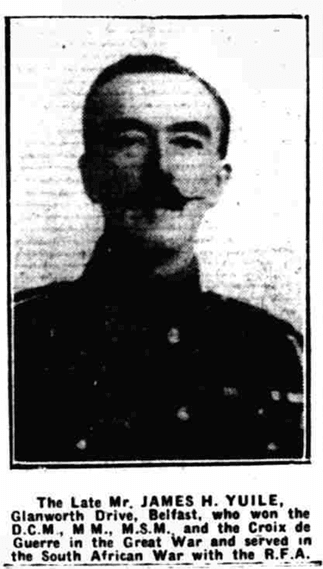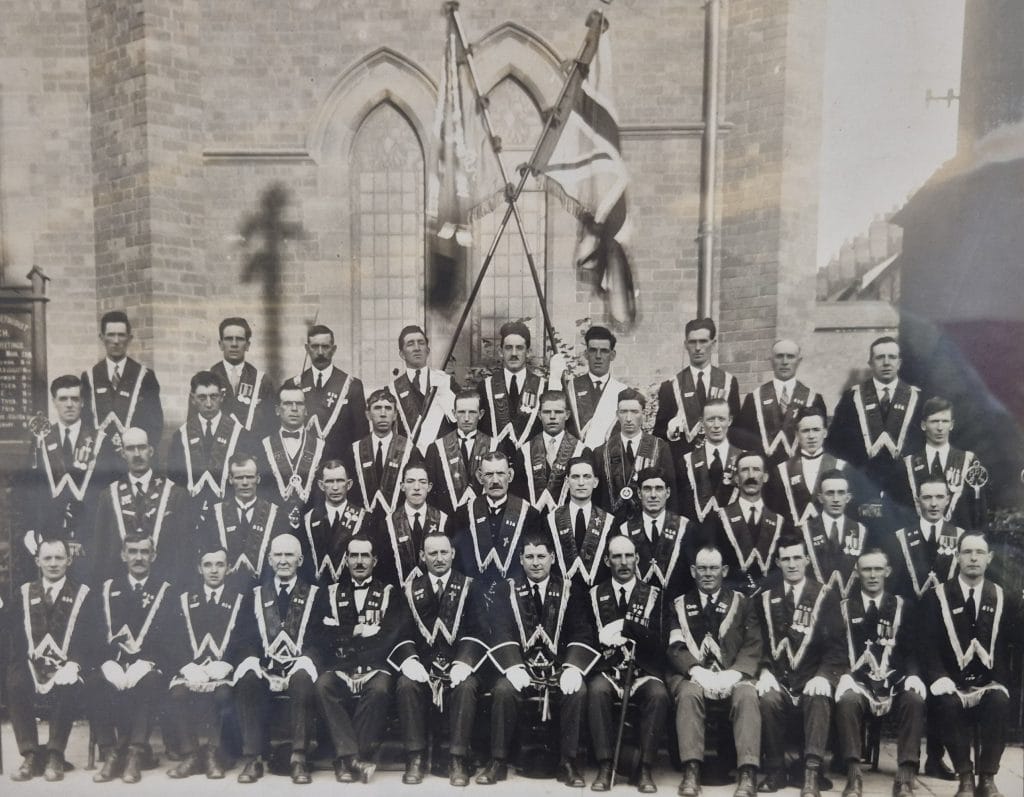Last year, we uncovered the interesting story of John McFarland and the Royal Armoured Car Division, that was active during the First World War on the eastern front. Since then, his story has been retold during open days and tours of Belfast Orange Hall, not only as an example of the work that has been undertaken as part of the Great Place North Belfast project, but as an example of the wealth of history that can be told and connected with our city. As we tell more and more stories of the people who used to call north Belfast home, we are discovering the relationships that bind these people together. For example, we found that William Condell was witness to Henry Gibson’s enrolment papers. In the tale of John McFarland, there was quite an obvious connection. On the Roll of Honour which hangs on the third floor of Belfast Orange Hall, just below the name of John McFarland is the name of his brother in law: James Hugh Yuile. Last year we acknowledged the connection between both men. Now, it is time for James Yuile to have his own story told.
Born in Clonmel, Co.Tipperary, on 3rd September, 1878 James was the first child of Dunbar and Mary Ann (Marion) Yuile. Dunbar was a soldier, and as a result, the family found themselves moving around the island of Ireland, with more children being born in Clonmel, Athy, Loughrea and Belfast. In total, Dunbar and Marion had 11 children, however, only 5 survived into adulthood. One of these was James’ eldest sister- Mary- who married John McFarland in 1906. We don’t know much about the relationship between James Yuile and John McFarland, however we can deduce from their respective marriage certificates that they were likely close friends, as James acted as witness to John’s marriage to his sister Mary, (perhaps not unsurprising as he was the oldest Sibling). When James married his wife, Susan Kerr, John was also witness to the marriage, which was held in Armagh, which hints at a stronger friendship than just “brothers-in-law”.
Over the course of the project, we have looked at a number of individuals who fought in the First World War. James Yuile is somewhat unique amongst them. He is the first “career soldier” who was enlisted in the military before the outbreak of the war. He is also the first person we have researched who survived the war.
James Yuile first enlisted on 5th October 1898 while he was still living in Clonmel. He joined the Royal Field Artillery, just in time to be deployed in the Second Boer War (1899-1902). He would remain deployed in South Africa until 1905 when he was transferred to the Army Reserves, but his service within the army was extended at his own request. He was then discharged in October 1910. This was just one month after his son, Frederick was born. To this point, James had a distinguished military career- highly decorated, having been awarded both the Queen’s and King’s South African Campaign Medal, with clasps charting his deployment and years of service.[1]
After his discharge from the army, James settled in Glenrosa Street, near Duncairn Gardens with his wife, Susan and son Frederick. The 1911 census notes James’ job as a Clerk, a far cry from his years as Gunner in the R.F.A. During this time, he was also prominent within the Orange Order, in particular, within the Gwynne’s True Blues Loyal Orange Lodge. His father had been a member of this lodge for a number of years and in 1913, James was Deputy Master, whilst his father Dunbar was Treasurer.

Given the timing of his discharge from the Army, coinciding with the birth of his first son, it is likely that the intention was to spend more time with his family and young Frederick. Tragically, his son would die at a young age, passing away in Purdysburn Fever Hospital of Scarlatina on the 24th August 1914. Shortly thereafter, on the 8th September 1914, James Yuile would go off to France to fight in the Royal Field Artillery once more. He once again excelled in military service, receiving numerous further commendations, including the Distinguished Combat Medal, Military Medal for Bravery, and the Croix De Guerre, as was highlighted on his role of honour. He served in France continuously from September 1914 until 1919 except for a brief period of furlough as the war drew to a close, before he would return to Belfast and reunite with his wife Susan. The couple lived on Glanworth Drive, and James -now a 21 year army veteran- became a member of the “B-Specials” or the Ulster Special Constabulary. As a decorated soldier in the aftermath of World War 1 he was also prominent in his local community, as newspapers record him attending a number of events in the North Belfast area as a noteworthy guest. He was fast establishing himself as one of the pillars of the community during the inter-war era. Sadly, he would not be able to enjoy his life in Belfast. James H. Yuile passed away on the 8th November 1925. He was being treated at the same hospital that his son had been, just over 11 years earlier, Purdysburn Fever Hospital. He is buried in Carnmoney Cemetery. His bravery and achievements while in the army were highlighted in his obituary, with members of many of the organisations which he was a part of, attending.
It is a cruel irony that a man who spent so long serving abroad got so little opportunity to enjoy civilian life. In the 6 years since he was discharged from the army after World War 1 he had established himself as a prominent individual within the communities of which he was part, but his sudden passing meant that he was never able to become one of those community cornerstones. It is best summed up by the obituary that was published, fittingly, on the 11th November 1925:
“By a pathetic coincidence it had been arranged that Mr Yuile should be one of the Ulster Ex-Service Men Association’s representatives at the ceremony of placing wreaths on the Belfast cenotaph to-day.”
It is worth remembering that not every soldier that went off to fight in World War 1 died on the ‘Front’. As more information becomes available to historians, we will be able to tell the story of those who came home, and not solely those who sadly died during the fighting. Although those survivors made it back to their families and communities, they often came back wounded and scarred, both physically and mentally. For others, such as James Yuile, (who appears to have navigated his various campaigns largely unscathed) they came back to a Belfast that had been vastly changed. James had lost a close friend and brother-in-law (John McFarland), as well as friends in the area and brothers from his Lodge. He had returned to a community and society in mourning, and a city that was navigating significant political change. For years, men like James H. Yuile had made their homes in the trenches and fields of the Western Front. The fighting ended with armistice agreement on November 11th, 1918, and the challenge for those who emerged from these trenches was to adjust to a ‘home’ away from the fighting: a home that was very different from the one they had left only a few years before.

About the archivist:
James Cromey is the Archive and Project Coordinator for the North Belfast Heritage Cluster. He has a background in Victorian, Industrial and Medical History and has received degrees from the University of Glasgow and Queens University Belfast. All research has been conducted to a high academic standard and has been fully referenced. If you would like to know more about a story or piece of research, or if you wish to tell us about your own story, email us at: archiveproject@nbheritagecluster.org
[1] One of the clasps awarded to James Yuile was enscribed “Belfast”. Whilst it is ironic given the City of Belfast was where he would spend his years after retiring, however, it relates to a battle during the second Boer War. This was likely the first significant battle that James took part in 1900 called the Battle of Berg-en-dal, also known as the Battle of Belfast.

